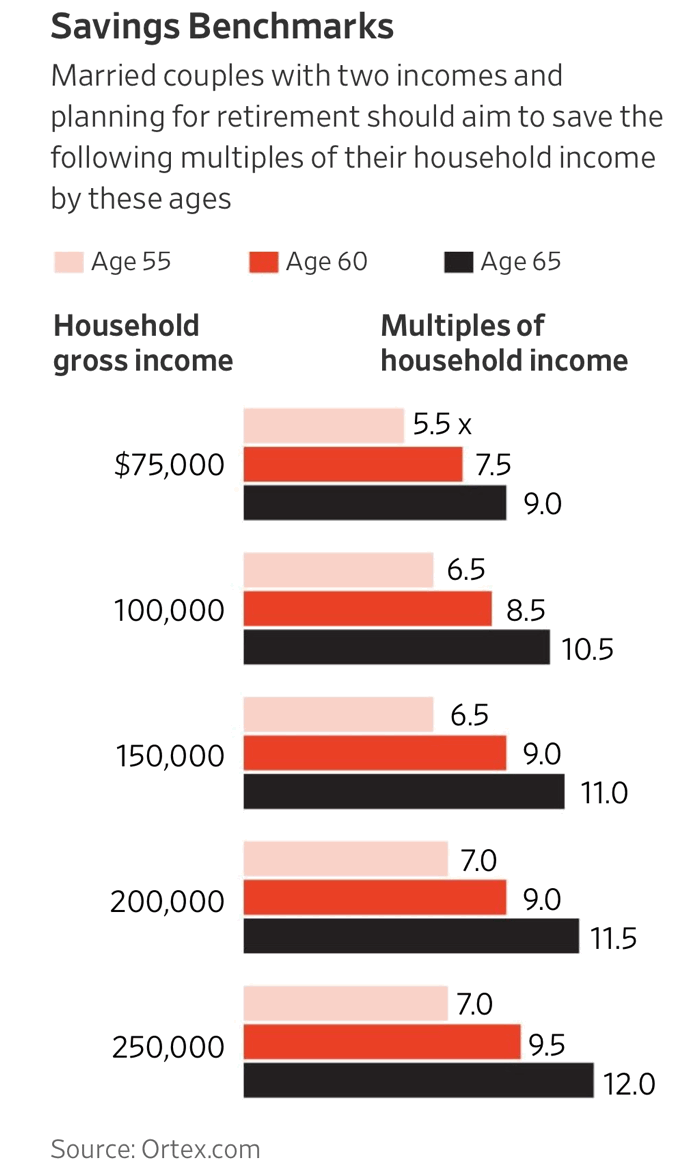 The WSJ article How to Know if Your Retirement Savings Are on Track tries to answer what is likely a very common question:
The WSJ article How to Know if Your Retirement Savings Are on Track tries to answer what is likely a very common question:
My wife and I are in our early 50s. We hope to retire in about a dozen years, and we are trying to figure out if our nest egg is on track. How large should our savings be at our age?
Obviously, everyone’s situation is different, but the WSJ appears to have collected the rules of thumb from a few big financial firms – including Fidelity, T. Rowe Price, and JP Morgan – and averaged them into this chart:

The chart indicates that a couple with a gross household income of $75,000 should target a nest egg of $412,500 at age 55, with that number increasing to $675,000 by age 65. The multiples get bigger with a higher income, I am assuming due to the resulting higher tax rates. It is also unclear if these numbers make any assumptions about Social Security income, but it seems like it does as the numbers appear too low otherwise. I am guessing that they simply assume that the average household spends at least 80% of their income, and bases the Social Security and taxes on that.
Using gross income ignores your actual expenses, but I acknowledge that this is a rough “rule of thumb” and many more people know their gross income than their annual expenses. An alternative rule of thumb is the “4% rule”, which says that you should expect to be able to safely withdraw roughly 4% of your balanced stock/bond portfolio per year (for 30 years) without running out of money. This equates to a rule of saving 25 times the income you want produced. You may already have other income sources. Need $30,000 of annual income above Social Security and a small pension? Then 25 times $30,000 = $750,000 at retirement age.
Perhaps just as importantly, the target moving from 5.5X to 9X income after only 10 years definitely shows (and relies upon) the power of late-stage compounding when a nest egg is already growing. If you manage to get to 5.5X at age 55, your portfolio returns may already be significantly greater than your additional savings in any given year. You have momentum on your side.
This brings me back to my overall reaction to these types of charts. If you are starting with a modest amount, these are huge, scary numbers. They can be so big, you think, why even bother trying? For most people, the key to retirement savings is setting up a system of regular savings and investment, and then letting it run with minimum interruption for 20, 30, 40 years. Focus on setting up the auto-save. Once you get to 1X income, and all the rest will suddenly seem possible.
 The Best Credit Card Bonus Offers – 2025
The Best Credit Card Bonus Offers – 2025 Big List of Free Stocks from Brokerage Apps
Big List of Free Stocks from Brokerage Apps Best Interest Rates on Cash - 2025
Best Interest Rates on Cash - 2025 Free Credit Scores x 3 + Free Credit Monitoring
Free Credit Scores x 3 + Free Credit Monitoring Best No Fee 0% APR Balance Transfer Offers
Best No Fee 0% APR Balance Transfer Offers Little-Known Cellular Data Plans That Can Save Big Money
Little-Known Cellular Data Plans That Can Save Big Money How To Haggle Your Cable or Direct TV Bill
How To Haggle Your Cable or Direct TV Bill Big List of Free Consumer Data Reports (Credit, Rent, Work)
Big List of Free Consumer Data Reports (Credit, Rent, Work)
Misses the mark since you really want to target 25X your expected expenses (not income). Actually a bit less since what you want is 25X your expected expenses less social security, and a bridge to get you to social security.
Expected expenses is a bit of a moving target since your actual expenses might include kids, mortgages, etc that may not be expenses once you retire.
And then there is taxes. Do you include taxes in you expected expenses (you should) or do you project after tax incomes and after tax expenses. Its endless.
Agreed on all that. Nothing can replace proper planning. It’s just interesting to see what these big firms use as a very rough rule of thumb, as it’s usually “number times something easy”. Just like the house you can afford might be 4 times your income or similar. I am betting they make some basic assumptions on Social Security income and taxes rates based on the fact that most people spend between 80-100% of their income.
Well said, It should be X times your expenses not gross salary. These firms would like everyone to keep working and pay their fees in due process
I’ve always felt these articles are written by financial planners. I tell younger people, save as much as you can and adjust your lifestyle to that amount. I agree the best way to handle retirement is to know your expenses.
Jonathan – as usual your take is spot on, with the last sentence in bold being the key. Due to challenges in my industry, I wasn’t able to start saving in earnest until around age 29. However, a focus on maximizing retirement contributions and minimizing investment expenses has me at age 42 well ahead of these “rules of thumb.” With the help of your excellent blog of course. I agree that the most important thing is to focus on just saving as much as you can, and not worrying too much about how big and scary the numbers look near the end.
As always, you hit the bullseye. I was a late starter (only had $600 in the bank at age 30 with a negative six-digit net worth) and it felt like it took forever (7 years) to reach the $100k mark in my retirement savings. But once I hit that magical $100k mark, the compounding became faster and almost exponential. I’m now almost 50 and am on track to retire in 10 based upon all metrics (gross income and expenses). So to all those youngins out there – – even if you feel like you’re not contributing enough, you’ve got the ultimate ally on your side: time and compounding. Never lose hope.